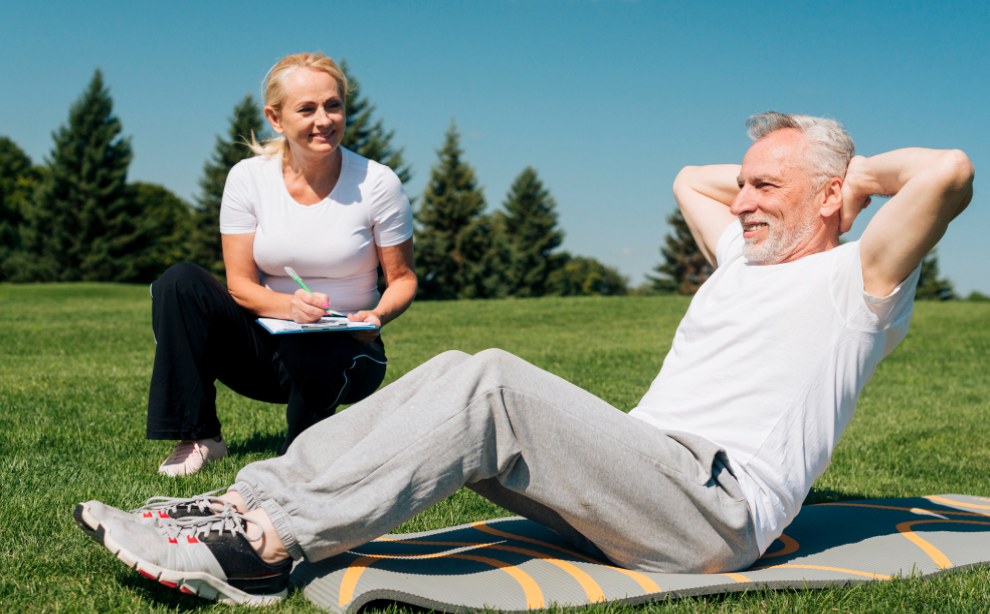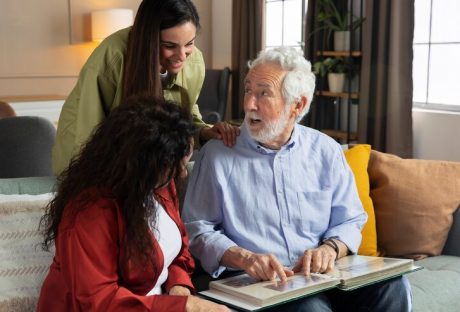Aging is a natural part of life, and staying active is essential for seniors to maintain a high quality of life. Many older adults face challenges when it comes to exercising, from chronic health conditions to a lack of knowledge on where to start. We understand the unique needs, focusing on exercises that improve balance while minimizing the risk of injury. Whether you’re a senior looking to stay fit or a caregiver seeking valuable insights, this comprehensive guide is for you.
This comprehensive guide explores the many benefits of exercise. It also offers guidance on safe and effective workout plans to individuals. This provides tips for making physical activity an enjoyable and sustainable part of your life.
Why Exercise Is Essential For Seniors?
Regular exercise provides a multitude of physical and mental benefits that enable seniors to stay active and engaged. According to the Centers for Disease Control and Prevention (CDC), it can help reduce the risk of chronic diseases, manage symptoms, and improve quality of life. For example:
Improves heart health: The American Heart Association states that staying active can lower blood pressure and cholesterol. This reduces seniors’ risk of heart disease by up to 35%.
Builds muscle and bone strength: Weight training and resistance exercises build muscle mass, which can prevent injury and reduce age-related muscle loss by up to 3% per year.
Boosts mood and cognitive function: Exercising stimulates chemicals in the brain that enhance mood, sleep, and memory, reducing the risk of depression and dementia.
Prevents loss of mobility: Strength, balance, and flexibility exercises keep joints supple and reduce seniors’ risk of falls and disability by 28%, per JAMA Internal Medicine.
Physical activity provides tangible benefits for both physical and mental well-being in aging individuals but also highlights the significance of consulting healthcare professionals, especially those specializing in adult primary care. Yet, to unlock these benefits, seniors must choose activities suited to their needs and abilities.
Tailoring Exercise to Senior Abilities
When designing exercise plans for seniors, several important factors are to consider:
Health Conditions: Seniors often have chronic conditions like arthritis, osteoporosis, and heart disease. Consult a doctor about safe activities and modifications.
Physical Capabilities: Assess factors like bone/joint health, balance, mobility, strength, and endurance. Choose exercises that target any limitations.
Interests And Goals: Focus on exercises the senior enjoys. This helps them set realistic health goals like building strength or improving balance.
Accessibility: Impact on exercise includes location, financial constraints, and transportation. Find low-cost and convenient options like at-home routines.
Getting input from healthcare providers, trainers, and the seniors themselves ensures regimens are safe, effective, and sustainable. Exercise programs, such as the ems suits, should evolve over time to match seniors’ changing capabilities and fitness levels.
Best Exercises For Seniors
Any physical activity has its benefits. Certain types of exercise lend themselves particularly well to seniors’ abilities. Incorporating a mix provides whole-body health improvements.
Aerobic Exercise
Engaging in low-impact aerobic activities can help improve cardiovascular health. Options include:
- Walking: A simple, accessible exercise that improves endurance.
- Swimming: Helps build strength and cardiovascular fitness without stress on joints.
- Chair Aerobics: Seated, low-impact movement to upbeat music.
- Tai Chi: Lowers blood pressure while working with balance and flexibility.
Aim to achieve at least 150 minutes of moderate-intensity aerobic activity per week, such as brisk walking.
Strength Training
Working major muscle groups combats age-related loss of muscle mass. Try:
- Body weight exercises: Squats, planks, and lunges use one’s weight as resistance.
- Resistance bands/tubing: Provides flexible resistance strength training.
- Weight machines: Begin with low weight and high repetition.
- Functional fitness: Use daily activities like standing from a chair, and carrying groceries.
Aim to have 8-12 strength sessions spread over 2 or more days per week.
Flexibility Exercises
Stretching, yoga, and Pilates keep muscles and joints limber. Benefits include:
- Improved range of motion and posture
- Reduced risk of injury
- Increased balance and stability
Aim to stretch major muscle groups 2-3 days per week.
Balance Exercises
Balance tends to decline with age, leading to falls. Specific activities to improve balance include:
- Tai Chi
- Standing heel/toe raises
- Walking heel-to-toe in a straight line
- Standing on one foot
To improve balance, perform balance exercises at least 3 days per week, with each session lasting at least 15 minutes.
Creating an Effective Senior Exercise Routine
When designing a holistic fitness regimen, keep the FITT principle in mind:
- Frequency: Aim for at least 150 minutes per week of moderate exercise. Include at least 2 days of strength training.
- Intensity: Moderate intensity is the safest and most effective for seniors. Use the “talk test” to avoid overexertion.
- Time: Start with 5-10 minute sessions and work up to 30 minute workouts.
- Type: Combine aerobic, strength, balance, and flexibility training for fitness.
Other tips for creating an effective senior exercise routine:
- Get guidance from a physical therapist or certified trainer.
- Focus on proper form and technique over speed.
- Warm up and cool down before and after exercising.
- Include rest days for recovery and to prevent overtraining.
- Track progress through activity journals or fitness trackers.
- Stay hydrated and listen to your body’s limits.
Tailor exercise routines to individual fitness levels, goals, and medical needs. The key is starting slow and building up over time. Patience and consistency are vital.
Exercise Safety Tips for Seniors
While physical activity is beneficial for older adults, follow these precautions to prevent risk:
- Consult your doctor, especially if you have chronic health conditions.
- Warm up with 5-10 minutes of light activity to prepare muscles and joints.
- Use proper form to avoid straining muscles or joints. Start to work with a trainer.
- Increase intensity over weeks and months to avoid overexertion.
- Listen to warning signs like chest pain, dizziness, or shortness of breath and stop activity if they occur.
- Wear supportive footwear with good traction to prevent falls.
- Stay hydrated and avoid exercise during extreme heat.
- Cool down with gentler activity after workouts to ease muscles.
Seniors should seek immediate medical attention if they experience symptoms like chest tightness or severe pain during or after exercising. Starting slow and maintaining safe habits are key.
Making Exercise a Lifelong Habit
To sustain motivation and make working out a regular lifelong habit, seniors can:
- Join community fitness classes designed for older adults to meet peers and enjoy group energy.
- Find an exercise buddy for mutual support and accountability.
- Incorporate activity into daily routines like housework or gardening.
- Track progress with a journal, app, or wearable device to stay motivated.
- Focus on enjoyment first by choosing activities you find fun and energizing.
- Listen to your body and be flexible about modifying plans when needed.
- Reward small wins and don’t dwell on temporary setbacks. Progress takes patience.
Staying active provides lifelong benefits for seniors’ health, independence, and enjoyment of life. Following the guidance in this ultimate guide can help older adults start and sustain customized exercise routines tailored to their unique needs and abilities. The key is taking the first step!
FAQs:-
Ans: Consult a physical therapist to design a program suited to your health conditions. Low-impact activities like water aerobics, chair yoga, walking, or Tai Chi. This can help improve strength and mobility without aggravating pain.
Ans: Simple strength exercises like squats or planks using your body weight are very effective. For staying active, consider chair aerobics, stretching routines, jogging in place, or engaging in activities like gardening and household chores. These can be effective ways to incorporate movement into your routine.
Ans: While some benefits, like better sleep or mood, can occur immediately. Research shows it takes about 6-8 weeks to begin noticing significant improvements in strength, balance, and cardiovascular health. Stick with the regimen to unlock the full benefits.
Conclusion:
And there you have it – a comprehensive guide to senior-friendly exercise routines, your ultimate key to unlocking a healthier and more vibrant life.
Staying active isn’t just a phase – it’s a lifelong habit. Join community classes, find an exercise buddy, and make it a part of your daily routine. Listen to your body, enjoy the journey, and celebrate small victories.
Remember, this guide is your companion on the path to a healthier and more vibrant you.
Take that first step, stay consistent, and relish the lifelong benefits that exercise brings. Here’s to a future filled with strength, balance, and joy!
Additional Reading:






















